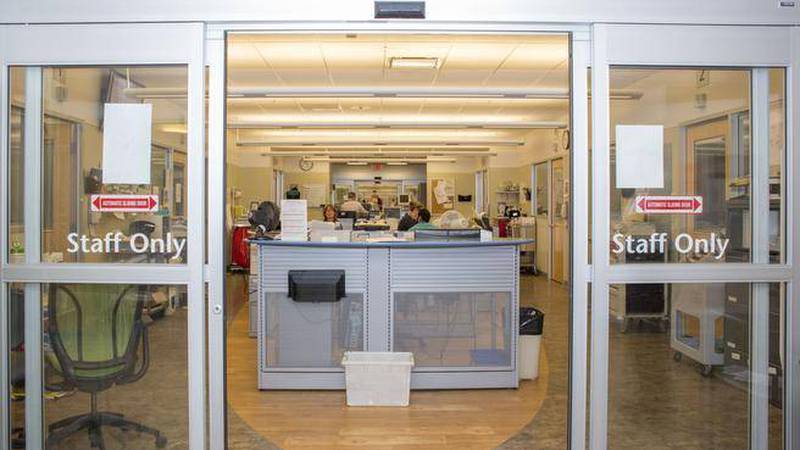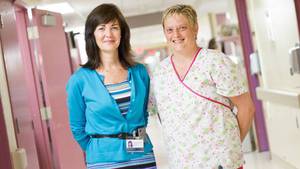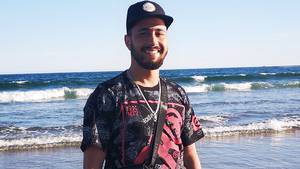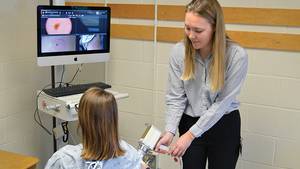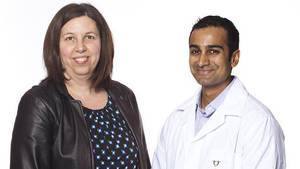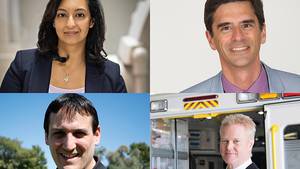 |
| Health Service Director of Emergency and Customer Service Sandra Janes and Department of Emergency Medicine Co-lead Dr. Sam Campbell. (Anita MacPherson Photography) |
When the Charles V. Keating Emergency and Trauma Centre opened in the QEII Health Sciences Centre five years ago, Dr. Sam Campbell and the Emergency Department’s multidisciplinary team seized the opportunity to push forward their vision of creating a leading centre for emergency health care.
“We’ve taken advantage of the new building and forging new relationships,” says Dr. Campbell, co-lead of the department of emergency medicine (ED) at the QEII’s Halifax Infirmary site.
By building stronger partnerships within the QEII and the larger healthcare community, and by implementing greater efficiencies within the department, the more than 65,000 patients who use the centre every year, for everything from broken bones to life-threatening traumas, are receiving better care.
“The change is palpable,” says Sandra Janes, who co-leads the centre and is the health service director of emergency and customer service.
A lot has changed since the QEII Foundation’s Working Miracles campaign helped the $20.4-million centre open its doors to the public in June 2009, lead by the Keating family and funded by the QEII Foundation and the Nova Scotia Government.
Not only are more patients being seen every day, but the complexity of their problems and healthcare needs is increasing. In order to treat the more than 190 people who use the centre daily, efficiencies were made on how patients are assessed and treated. By treating them in specific areas of the department, the amount of time they spend waiting for particular treatments is minimized.
Gone are the days of all patients being placed on a stretcher to wait. For those who don’t need a bed, the emergency department introduced a chair-centric area or pod, as well as a paramedic-assisted pod.
“By doing this, more patients with non-life threatening problems are provided with the care they need, while beds and other health care resources are available for the more critical-care patients who need them,” says Sandra.
In the department’s Pod 5 Area, doctors determine the care that’s needed and paramedics provide the resources to patients not requiring emergency nursing care. Advanced-care paramedics treat about 30 per cent of all ED patient visits in this area. The first of its kind in North America, the model has sparked interest in health centres across Canada. “There is a lot of excitement, not only with the concept, but also with the fact that the QEII implemented this model in North America,” says Dr. Campbell.
A strong partnership between the QEII’s Emergency Department and Psychiatry Service and the Capital Health Addictions and Mental Health Program also continues to improve patient care. Within the emergency department, psychiatric patients are assessed and treated in a quieter, dedicated space, which has decreased the amount of time they spend in the department – and, as a result, improved the flow of patients.
“Through system efforts to address bottlenecks within other areas of the QEII’s system, congestion has been reduced and the flow of patients through the emergency department has greatly improved,” says Dr. Campbell. “For example, better partnerships with the Department of Medicine means patients needing to be admitted to hospital now spend less time waiting in the emergency department beds which are needed to treat patients there."
On the other end, patients who are not actively sick, but can’t go home because they don’t have the right community support, are being managed better. “It wasn’t uncommon for people to spend a week in the ED waiting to go home,” says Dr. Campbell. A staff person from Continuing Care now works within the emergency department to find timely care outside of the hospital for patients.
With the QEII being the only adult learning health centre in Atlantic Canada and understanding education is key in creating a leading emergency health centre, an old ambulance bay was transformed for simulation training programs. Every week you’ll find trainees practicing resuscitation there. The simulation bay is not only educating residents, emergency room doctors, paramedics and nurses, but improving clinical care for patients, says Dr. Campbell, who is also a professor at Dalhousie University’s Departments of Emergency Medicine and Anesthesiology.
“We’ve made huge gains,” says Sandra. “The Charles V. Keating Emergency and Trauma Centre has definitely made it possible for us to provide the excellent care our patients, families and staff deserve.”

